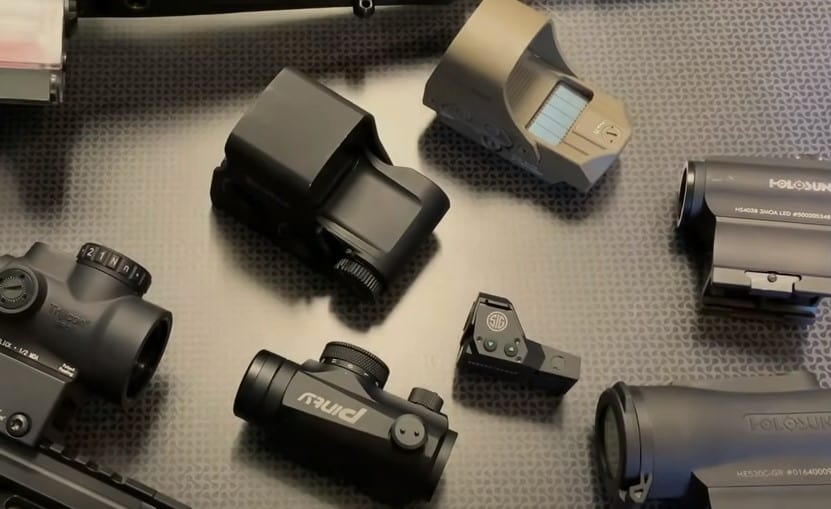Everything You Need To Know About Red Dot Sight Magnifiers

The use of red optics on rifles, shotguns, and even pistols has grown significantly in the last decade. In a short period of time, nearly every optics company in the world has begun producing some form of red dot optic.
Red dot optics are now being made by companies like Leupold, whose bread and butter was always magnified rifle scopes. Red dot optics are great for close-quarters combat and high-speed shooting.
Beyond two hundred yards, they become less effective. If you are tasked with shooting a small target at only 100 yards can be difficult. This is where a magnifier comes in.
What’s a Magnifier?
The name is a little self-explanatory. It’s something that magnifies. The idea behind a magnifier is to turn your 1x fixed power red dot into a magnified optic.
Magnifiers are placed behind the red dot optic and give the user what amounts to a very basic magnified optic. Magnifiers are produced by a wide variety of companies and have even been adopted by the United States Army. A magnifier is a very simple lens that requires very little adjustment.
A magnifier increases the user’s effective range, and makes taking precision shots much easier. In some cases, a magnifier is absolutely necessary to establish proper target identification.
Seeing a deer is easy; making sure that deer is legal to shoot is a whole other story. A magnifier gives you the confidence to take your shot.
Magnifier versus Variable Scope
So why would one equip their rifle with a magnifier and red dot over a variable or fixed power scope? Well, the biggest benefit is going to the ability to retain a red dot’s strength and aid in eliminating their weaknesses.
A red dot allows for rapid, close range target acquisition, as well as rapid target acquisition. A variable scope with a 1X setting is still going to require proper eye relief and good cheek weld to use. A red dot will almost always have unlimited eye relief and can be used with a compromised cheek weld.
With the right mount, you can instantly swap between a magnified optic to a red dot. So, you essentially get the best of both worlds in some ways.
However, a variable or fixed power magnified optic will often feature additional reticle features. These features will often allow for making long range shots or shots in a windy environment much easier.
These features come in the form of Bullet drop compensators, MOA or MIL dots that allow for range and wind compensation.
When choosing between the two, you really need to identify your individual needs. If you plan to do a lot of shooting at close range and some at longer ranges, go with the red dot and magnifier.
If you are more likely to take ranged shots go with the variable scope. You can also pair optics with weapons. For example, I most brush hunt with a shotgun, and occasionally use slugs with it.
In this situation a red dot for buck and birdshot is perfect, and a magnifier is handy when it comes to shooting slugs.
Magnifier Compatibility
When purchasing a magnifier for an already own red dot you should ensure the magnifier is compatible with your red dot. Now matching your magnifier to your optic is the simplest way to ensure compatibility.
By matched, I mean a magnifier and red dot from the same company. Companies like Aimpoint, Eotech, and Vortex all produce both red dots and magnifiers. That being said, you can mix and match optics from different companies in many cases.
The issue is to look for basic height compatibility. What you most commonly come across is Standard AR height. This is an industry standard that allows red dots to co-witness with AR height iron sights.
Most standard red dot optics are designed to co-witness with a AR 15, and if not, mounts can help a lot with raising or lowering a red dot.
Durability
Durability is a concern with any optic. Let’s be real; optics are often combinations of glass and aluminum. There is a lot of potential for absolute failure.
When it comes to durability, the major optic companies are going to offer the highest level of durability. Aimpoint’s magnifiers are issued to the U.S. Army and have proven they can take a lot of abuse.
Both Aimpoint and Eotech magnifiers are very durable and quite reliable. The issue is of course, price. You pay a premium for a go-to-war optic.
If you are just a casual shooter or even a casual competitor, brands like Vortex, Primary arms, and even UTG if you are on a budget. These will be perfectly capable of withstanding years of shooting and use, but you wouldn’t jump out of a plane over Syria with them.
Size and Weight
Here’s a big issue with adding anything to a close-quarter rifle, weight. A rifle designed for close-quarters use is a rifle that needs to be used fast, and a lot of weight can slow a rifle down.
Keep that in mind when choosing a magnifier and a mount. In some situations, weight won’t also matter, like my slug gun, but for defensive purposes, it’s best to stay lightweight.
You must consider the length of the magnifier. Some are quite compact, and others can be quite large. Aimpoint’s 6x scope is quite long.
Some weapons may not have the necessary rail length to utilize a larger magnifier. Back to my slug gun, it has a very short rail with limited room across the top of the receiver. A long magnifier simply wouldn’t fly without some severe awkwardness.
Eye Relief
Eye relief is the distance from your optic to your eye. Improper eye relief will result in an unclear sight picture and can cause a variety of issues with accuracy and precision.
Magnifiers will often require a close eye relief, generally around two inches. This can be an issue if you are using a powerful weapon.
My slug gun, for example, has some recoil to it, and if I’m too close to the optic, I’m walking away with a black eye.
There are a few long eye relief magnifiers, and this may be a concern to have. Your average modern sporting rifle won’t be an issue, but bigger, harder-hitting guns are.
Clarity
With a red dot, clarity isn’t the biggest issue. Just due to their nature, you aren’t using them to examine tons of details of a certain thing. However, when we add magnification, it starts to become a bigger issue.
Magnifiers should have a lot of the same features as variable optics. They should use HD glass, have coated lenses, and be great at gathering and transferring light.
Mounting Options
Lastly, there are mounting options. Lots and lots of different mounts out there that all offer different strengths and weaknesses.
My preferred is the flip-to-side mounts that can instantly get the magnifier out of the way for access to the red dot. Aimpoint produces a twist-off variant that turns a magnifier into a monocular.
Again, consider different mounting options, and if your magnifier doesn’t come with a mount, it would be prudent to research compatible mounts, as well as consider the cost.
Parting Shots
Magnifiers are excellent tools for any rifle with a standard red dot. Adding a magnifier into the mix makes your rifle a more versatile weapon.
A simple magnifier can extend your effective range by several hundred yards and make hitting small targets a real possibility.

